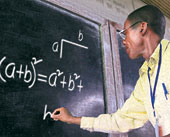 |
| Simple equation: Media ignores math practitioners. |
It is a rare sight in India: A mathematics teacher in a television commercial for mouth freshener. This is unusual because popular media in this country has no place, or time, for ‘cerebral’ activities such as mathematics. There are more surprises in the commercial; one could see ‘commutative’ and ‘distributive’ properties of addition being scribbled on a blackboard. This is no short of a mini revolution! However, the revolution stops here and mathematics teacher archetype takes hold. One look at the teacher and viewer is convinced that the familiar math monster hounded the person who created this commercial.
The stern looking actor playing the teacher conveys the message that people who love the subject hate to hear. “This is darn serious”, he seemed to say with his eyes. The mouth freshener advertisement conveys a different message. “Use the mint and fool the smartest guy (read your mathematics teacher) in town,” it screams at the viewer. Curled up on his couch, the viewer may not take the message seriously but that is only a part of the story. Subliminal messages roam our brains long after an event is over and at times reinforces hidden fears. Already we are at our wits end in trying to protect young minds from mathematics bugbear and this kind of messaging only adds to our woes.
Mathematics teaching is a serious business and portrayal of its practitioners on popular media should be given a careful consideration. A few in the mass media care about these things. No wonder, India’s most popular forms of entertainment ? Hindi films and cricket ? have never taken mathematics seriously. We would not expect a film on Srinivasa Ramanujan or a play on Bhaskara. Those who have seen A Beautiful Mind on mathematician John Nash, or the East End play Copenhagen on Niels Bohr-Werner Heisenberg meeting would agree that a sensitive portrayal only help this human activity. Mathematicians would gloss over the inaccuracies in such efforts and join hands in applauding them.
Teenagers’ sporting of Albert Einstein’s famous equation on their T-shirts is no barometer for mathematics literacy. Years of training in recognising the patterns help people become mathematicians. Over the millennia, cultural conditioning has helped humans to get attuned to mathematics. Without getting into the nature-nurture debate, it could safely be concluded that we have become mathematically conditioned to such an extent that even illiterate people can perform rudimentary addition and subtraction without fear.
To build on this ‘innate’ knowledge one needs nurturing and here we seemed to have hit a stumbling block ? the fear of mathematics. We need to remove the cobwebs where the fear spider resides and if a mathematician selling mouth freshener can do it, so be it.











